SPONSORED CONTENT
Editor's note: Learn more about new behaviors, beliefs and changes in the economy in this collection of sponsored reports.
New InsightsNow E-Book: Six Ways to Use Implicit Testing
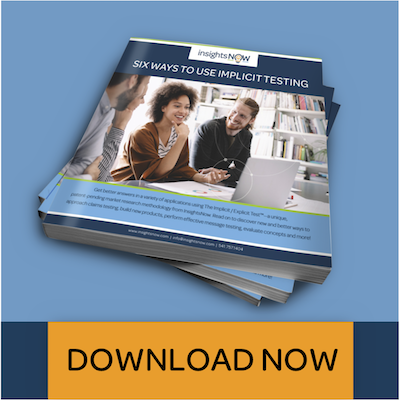 Get the right answers using The Implicit / Explicit Test™: a unique, patent-pending market research methodology from InsightsNow. Download our new e-book, “Six Ways to Use Implicit Testing” to discover new and better ways to uncover insights about:
Get the right answers using The Implicit / Explicit Test™: a unique, patent-pending market research methodology from InsightsNow. Download our new e-book, “Six Ways to Use Implicit Testing” to discover new and better ways to uncover insights about:
- Claims testing to achieve behavioral impact: Using implicit testing, you determine what claims are most relevant and impactful to your target consumers.
- Ingredient scoring to build clean-label products: The Implicit / Explicit Test allows you to compare and contrast consumer reactions to ingredients.
- Ingredient benefit associations for functional product design: Uncover which ingredients need to be implicitly associated with your claim or brand positioning –including knowing what to name ingredients.
- Message testing for media targets: The Implicit / Explicit Test provides a gauge into how the message, and the respective media source, interact to achieve an implicit or explicit believability response.
- Emotions testing to understand product experience: Utilize special implicit techniques using an indirect prime response to accurately measure emotions and apply to product innovation and development.
- Concept scoring to uncover category lift: Implicit testing allows you to understand the motivational drivers underlying category choice.
By studying implicit and explicit reactions in market research, researchers are able to gather the insights needed to impact future consumer behavior – either by nudging current behaviors along or disrupting behavior to drive new choices. Researchers, product developers and marketers can make better decisions and create realistically achievable metrics for all key stakeholders and for the supply chain. How can you use implicit testing to translate insights into the right approach to product development or innovation, and marketing and messaging?
A Consumer Finance Perspective on the “New Normal”
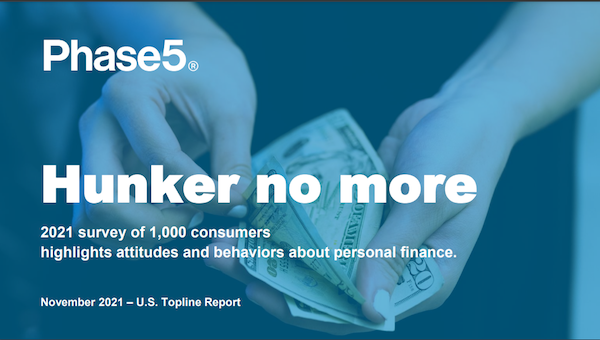 With 2021 drawing to a close, it has been nearly two years since most of us first heard of COVID-19. Without a doubt, everyday life has changed and, in some ways, we will never be the same. The impact has been felt across both our personal and our professional lives, leaving many of us wondering if we have arrived at the “new normal” yet, and what exactly that means in this hopefully soon-to-be post-pandemic world.
With 2021 drawing to a close, it has been nearly two years since most of us first heard of COVID-19. Without a doubt, everyday life has changed and, in some ways, we will never be the same. The impact has been felt across both our personal and our professional lives, leaving many of us wondering if we have arrived at the “new normal” yet, and what exactly that means in this hopefully soon-to-be post-pandemic world.
In 2020, Phase 5 conducted an initial study of over 2,000 North American consumers to better understand how COVID-19 was affecting their attitudes and behaviors toward financial services. In 2021, we returned to the U.S. market with that same study plus a few additional questions given the context and wisdom provided by another year.
Findings from this new study (and its comparison to previous results) have given us insights regarding key elements of the “new normal,” and how financial institutions need to evolve the products, services and experiences they deliver to meet consumers’ evolving needs.
The New Normal: Fall 2021 Industry Trends
Where do we go from here? It’s the question everyone’s been asking. Provoke Insights is excited to announce the third wave of our in-house research, which is designed to track consumer purchasing habits, pandemic-related concerns and groundbreaking industry trends.
Provoke Insights surveyed 1,500 Americans between the ages of 21 and 65. Our rich data set also reveals how the pandemic continues to impact a wide array of industries. This data is crucial for brands looking to navigate today’s ever-changing markets.
Provoke Insights developed 17 quick-to-read reports:
- Alcohol

- Beauty
- Children
- Clothing
- Employee Office Sentiment
- Finance
- Fitness/Exercise
- The Holidays
- Jewelry and Watches
- Media
- Produce
- Radio
- Restaurants
- Retail
- Streaming Services
- Technology
- Travel
Key findings from the study include:
- Optimism has increased since the start of the pandemic with 76% of Americans self-describing as optimistic about the future.
- Forty-two percent of Americans are still concerned about shopping in-person, a significant decrease from a peak of 55% in 2020.
- Vaccinated Americans are more concerned with in-person shopping (52%) than those who are unvaccinated (44%).
Decision Analyst: Consumer Reactions to COVID-19
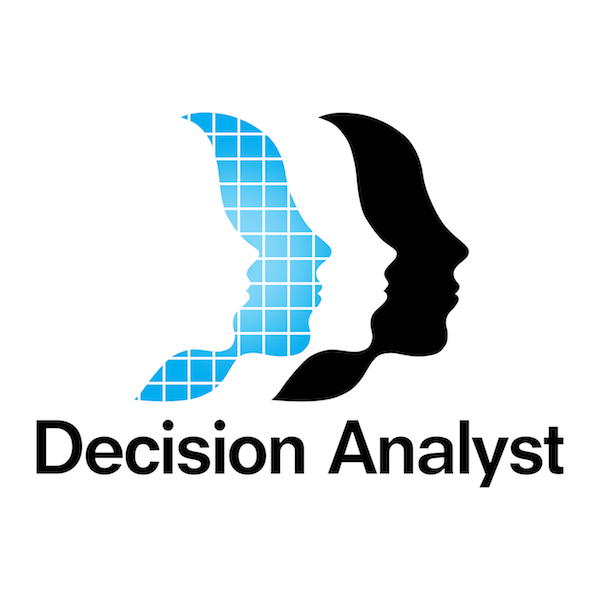 In spring 2020, when COVID-19 began to have a bigger impact nationwide, Decision Analyst started fielding a research study to understand a number of issues Americans were facing. Our resulting “Consumer Reactions to COVID-19” report contains insights gathered over 20 waves from more than 12,000 U.S. consumers. Here are a few examples:
In spring 2020, when COVID-19 began to have a bigger impact nationwide, Decision Analyst started fielding a research study to understand a number of issues Americans were facing. Our resulting “Consumer Reactions to COVID-19” report contains insights gathered over 20 waves from more than 12,000 U.S. consumers. Here are a few examples:
- Concerns about COVID-19 ebb and flow with the virus. When we first surveyed consumers in mid-March 2020, we learned that 60% of American adults were extremely or very concerned about the COVID-19 pandemic. By October 2021, that number had dropped to 42%.
- The pandemic has shown that a sizable number of Americans realize they should be saving, or saving more, for retirement. Among those already saving, about half feel they should be saving more.
Other topics include: consumer mind-set segments, level of concern, emotions/stress, health/weight changes, personal experience with the virus, impact on leisure travel, impact on health care attitudes and impact on home/family/retirement.
Across the waves, some parts of our survey have remained constant, while others have been added or removed. In May 2021, we added attitudinal and emotional segmentation to the survey. Respondents are profiled based on a spectrum of COVID-19-related emotions and attitudes. The segmentation will be made available for client use in custom studies. It will be extremely valuable for profiling a brand’s customer base for optimal understanding, targeting and communications.
Visit our website for more insights and to download our free report.
Dedoose Equips You with the Survey Analysis Tools Your Team Needs
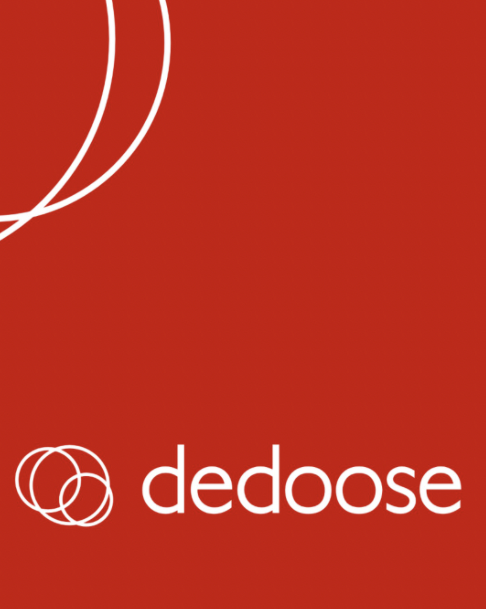 If you are using qualitative data analysis software (QDAS), why not compare your experience with our cloud-based app for data analysis? Dedoose is an affordable tool for survey research which permits easy access to media, coding and visualization tools for an affordable monthly subscription.
If you are using qualitative data analysis software (QDAS), why not compare your experience with our cloud-based app for data analysis? Dedoose is an affordable tool for survey research which permits easy access to media, coding and visualization tools for an affordable monthly subscription.
Single users, teams or colleagues who collaborate remotely will enjoy built-in features such as the integrated chat window, and the ability to conduct inter-rater reliability analysis. Whether your project is qualitative or quantitative, Dedoose is the tool that can help to make your survey research easier!
If you still need convincing, our short video will show you how to use the Dedoose survey import tool and understand the features that can help you dive more deeply into your data. Coding themes, for instance, can be created, edited and updated in real time as they evolve! What's better is that your team can enjoy all the bells and whistles of Dedoose for around $15 per month.
Don't wait: insist on receiving the qualitative and mixed-methods support you and your team need, when you need it. Get ready to put your survey analysis worries to rest with the data analysis app created by researchers, for researchers!
Our video was recorded in November 2021 using Dedoose Version 9.
The 2022 Buyer’s Guide to Market Research Software
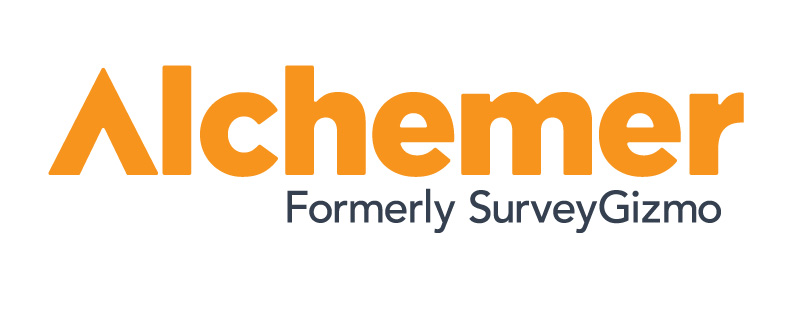 Market research software is used by market research agencies, individuals and companies large and small to collect and analyze data, so they can make better, data-driven decisions. They package survey building and sending tools together with data reporting and analysis tools, all in one platform. This means researchers can use a single tool to quickly run studies, gather results and generate actionable insights.
Market research software is used by market research agencies, individuals and companies large and small to collect and analyze data, so they can make better, data-driven decisions. They package survey building and sending tools together with data reporting and analysis tools, all in one platform. This means researchers can use a single tool to quickly run studies, gather results and generate actionable insights.
Market research software is the most important tool a market researcher can have in their toolbox. Without it, companies lose significant insights that drive brand, market and customer decisions. This is a key reason why agencies are purchasing this technology in droves. But choosing a market research software platform can sometimes be confusing. Many options that look similar are built for different purposes and use cases. This buyer’s guide to market research software aims to arm decision-makers with the information they need to make the right decision for their business.
